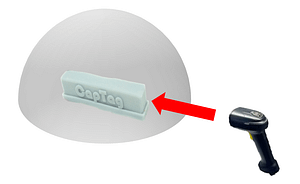CapTag Technology explained
CapTag’s Disruptive Technology makes
bottles and objects smart
enabling Digital Transformation
of any business’s processes
through long range, item level, tracking.
The key difference between CapTag® and conventional RAIN UHF RFID labels, or on-metal tags is the use of CapTag® proprietary patent protected
grounded monopole RFID technology
as distinct from the dipole UHF RFID technology used in conventional labels and on-metal tags
and which also enables a range of on-anything tags
See it in action for bottles on YouTube
Why is monopole technology different
The significant factor in the difference between monopole and conventional dipole RFID technology is that:
- a monopole antenna is a type of antenna with a single conductor (the “pole”) that radiates above a ground plane. Think of it like a vertical rod standing on a metal sheet – or a lightening conductor going to ground.
Whereas a dipole antenna consists of two conductors of equal length and uses those two radiating elements (a virtual ground plane) for a symmetrical radiation pattern.
Dipole antennas are designed to radiate and receive signals in a specific way, and their performance can be affected by the surrounding environment. When placed on a bottle, the water significantly alters the antenna’s radiation pattern and impedance, leading to poor performance.
CapTag® labels and tags, which all work on a grounded monopole principle have been developed with 10 patents granted as well as 2 further applications in progress, to uniquely use the radio absorption to read bottles, at high speed and from metres away
… and, as no line of sight is needed, those bottles can also be read inside sealed cartons, wooden cases, or when clustered on shelves or conveyors
– unlike QR or traditional barcodes.
In summary
- Monopole antennas are often better for RFID tagging of bottles, especially those containing liquids or alcohol, due to their reduced sensitivity to the detuning effects caused by nearby conductive or high-dielectric materials.
- Dipole antennas are better suited to dry goods or carton packaging, or where tags can be placed farther from the liquid
On Metals – and On Anything developed by CapTag
When dealing with RFID tagging on metal surfaces, the choice between monopole and dipole antenna designs is critical because metals drastically affect tag performance due to detuning and signal reflection.
CapTag have developed an enhanced variation of grounded monopole technology which delivers significant benefits over standard on-metal tags and enables compact on-anything tags.
When on metal, or near liquid, the tags use the CapTag proprietary grounded monopole principle; when in free space, or on non-metallic surfaces, they automatically becomes a standard dipole RFID antenna tag – so enabling a unique On-Anything tag
The key benefits being:
- a hemispherical read envelope with almost no ‘end-on’ read issues experienced by competing on-metal tags so they can be read at long range from above and around the sides of the tag.

OM & OA hemispherical read envelope
- Twice as sensitive as competing On-Metal RAIN tags
- Do not need to be in complete contact with the surface to work well. Ideal for painted metal surfaces, metal beer kegs, shopping trolleys, hospital equipment, cables, fluid containers, cylinders, consumer products etc. even curved surfaces
- Can be positioned on assets in places where tags cannot be read from the top of the tag e.g. at the base of roll cages, metal trolleys when only end-on reading is feasible